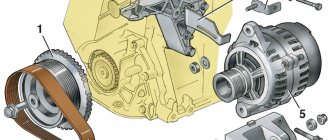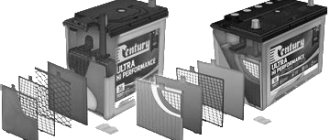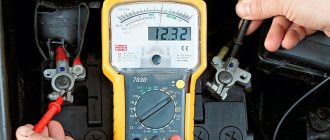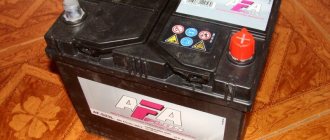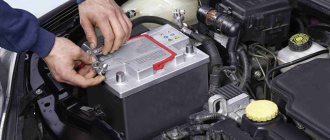Home » VAZ repair
Reading time: 9 minutes. Updated 08/04/2019
If a battery that is more than 5-7 years old is not charging , then the answer to the question is: “ why ?” most likely lies on the surface. After all, any battery has its own service life and over time loses some of its basic performance characteristics. But what if the battery lasted no more than 2 or 3 years, or even less? Where then should we look for reasons why the battery does not want to charge? Moreover, this situation occurs not only when recharging from a generator in a car, but even when it is replenished from a charger. Answers must be sought depending on the situation by performing a series of checks followed by procedures aimed at eliminating the problem.
Most often, you can expect 5 main reasons that manifest themselves in eight different situations:
| Situation | What to do |
| Oxidized terminals | Clean and lubricate with special lubricant |
| Broken/loose alternator belt | Stretch or change |
| The diode bridge has failed | Change one or all diodes |
| Voltage regulator faulty | Replace graphite brushes and the regulator itself |
| Deep discharge | Increase the charging voltage or reverse polarity |
| Incorrect electrolyte density | Check and adjust to the required value |
| Sulfation of plates | Perform a polarity reversal, and then several cycles of full charge/discharge with low current |
| One of the cans is closed | Actions to restore a battery with such a defect are ineffective |
The main reasons why the battery may not charge
To understand in detail all the possible malfunctions due to which the car battery does not charge, first of all, clearly define the situation:
| The battery quickly discharges and dies | or he | does not charge at all (does not accept charge) |
In general, when the battery refuses to charge, the following options are allowed:
- plate sulfation;
- destruction of plates;
- terminal oxidation;
- decrease in electrolyte density;
- short circuit
But you shouldn’t worry so much right away, everything is not always so bad, especially if such a problem arose while driving (indicated by a red battery light). It is necessary to consider special cases in which the car battery does not take charge only from the generator or from the charger as well.
The charging system of a car battery contains a number of external devices, on which the performance of the battery itself and the charging process can also greatly depend. To check all external devices, you will need a multimeter (tester); it will allow you to measure the voltage at the battery terminals under different engine operating modes. You will also have to check the generator. But this is only true when the battery does not want to be charged from the generator. If the battery does not take a charge from the charger, then it is advisable to also have a hydrometer to check the density of the electrolyte.
Why is my car battery not charging?
First you need to clarify two things.
The battery does not charge due to its failure or because it does not receive charging current from the generator.
This will be indicated by a burning red light with a battery symbol. To make sure, you need to check the voltage at the battery terminals with the engine running. It should be within 13.5-14.5 V.
You can also check the battery by charging it from the charger. If there is no charging, then it is a defect in the battery itself.
The malfunction may be due to the following reasons:
- service life has expired. Usually it is 5-7 years;
- terminal oxidation;
- low electrolyte density. Measured with a hydrometer. The norm is 1.25-1.29 g/cu.m. cm. Decreases with evaporation of the electrolyte;
- plate sulfation. Occurs during deep discharge, strong cooling, long-term storage of an uncharged battery, increased electrolyte density;
- short circuit in one of the cans;
- destruction of plates;
- reversal of poles;
- impurities in the electrolyte.
If the battery is recharged well from the charger, then the reasons for its discharge may be:
- generator belt break;
- belt stretch;
- oxidation of wires on the generator;
- failure of diodes;
- wear of generator brushes;
- failure of the relay regulator.
Poor battery charging can occur without a malfunction. This happens if there are short runs between frequent engine starts. He simply does not have time to recharge.
Causes of car battery charging problems
You can determine why the battery is not charging if you use an effective method.
This is interesting: Causes of valve knocking on a cold engine and how to eliminate them
Reduced density of electrolytic composition
A hydrometer is used to check density. Testing is carried out for each jar. The new battery has a density of 1.26–1.27 g/cm3. As the battery charges, the density of the electrolytic composition gradually increases. If the density level does not change, then the car battery does not charge. Problems with the electrolytic composition are also indicated by the presence of suspension and turbidity.
The recovery procedure is performed at the following intervals:
- The cloudy composition is carefully drained. For these purposes, rubber gloves and protective clothing are used. After all, the electrolyte contains components that can cause harm.
- Purified distilled water is used to rinse jars.
- When pouring a new electrolytic composition, the degree of density is monitored. If necessary, the car battery is charged.
When washing, monitor the condition of the lead plates and contacts.
Short Circuit in Lead Plates
The battery will not charge from the charger if the lead plates are short-circuited. This happens due to partial or complete shedding of lead, its contact with the conductive terminals and ends of the electrodes.
Another reason for short circuit is failure or wear of separators. This brings the negative and positive terminals into contact. Various deformations lead to such effects.
In some cases, cans can be restored. If such actions cannot be carried out, then the battery is replaced.
Sulfation of lead plates
Often the battery does not take a charge due to the formation of plaque (sulfation) on the conductive terminals. This effect occurs because the power supply is not fully charged for a long time. At the initial stage, the battery is restored. To do this, cyclic charging is performed.
The power source does not charge completely even if the integrity of the case is damaged. After all, this provokes the leakage of the electrolytic composition and evaporation of the liquid. To seal microcracks, soldering and adhesive are used. Restoration is carried out after draining the electrolytic composition, washing the cans and drying the body.
Cleaning of conductive terminals is carried out according to a certain scheme:
- The power supply housing and banks are washed. For this purpose, distilled water is used.
- The thoroughly dried battery is filled with an electrolytic composition with the required density. Using the charger, the source is recharged. During the process, the density is checked. If necessary, administer liquid or distilled water
- The charging unit does not turn off until it charges the battery. Every section is checked.
- If the power source or battery on the laptop does not charge, then the charger is turned off. Check the density and fill in the electrolytic composition.
The sulfation process is often confused with the destruction of lead plates. This is not difficult to identify. To do this, check the electrolytic composition. If there are particles or suspension in it, then it is better to replace it.
Problems with the generator
The battery does not charge from the generator due to a number of reasons. In order to quickly identify these problems, you need to know their characteristics.
Belt problems
If the generator does not charge, then the problem may lie in the integrity of the belt. Even an inexperienced car owner will detect serious damage. It is more difficult to determine its weakening. Indeed, in this case, the generators either provide charging or not.
To identify problems with the belt, look at the indicators and lights. They glow almost constantly. To eliminate this, tighten the belts or completely replace them.
Faulty diodes, regulators, brushes
The generator does not charge the battery if faulty diodes are included. Such elements are identified using multimeters or testers. It is possible to replace one diode or the entire bridge. Incorrectly functioning elements cause the battery to be poorly charged or recharged.
When the power supply is overcharged, the diodes, which are operating normally, heat up. Voltage surges result from the use of an ineffective regulator. It is replaced immediately.
Poor charge occurs because the brushes that make up the generator wear out. If the replacement is not made, the generator does not charge the power source.
Polarity reversal
If the battery of a laptop or vehicle is completely discharged, perform a polarity reversal. If done correctly, the power supply will charge. Polarity reversal can be performed if changes in the poles can be observed. Otherwise, the charging unit should not be connected.
This is interesting: Signs and causes of car alternator malfunction
When determining pole reversals, you should focus on the capacity of the cans that are included in lead-acid batteries, but not other sources. For recharging, use only those chargers that are equipped with protective elements.
Polarity reversal is not performed if:
- The electrolytic composition has become cloudy and the charged car battery is quickly discharged.
- The lead plates were destroyed.
- KZ banks, which is included in the composition.
- Low composition density.
Overload
Why does the battery receive a charge, but the voltage does not increase? The main reason is generator overload. This is caused by the connection of standard and non-standard electrical equipment, various gadgets and installations. In this case, the generator operates at the limit.
Such difficulties arise for new car enthusiasts. After all, they use a variety of units and devices, acoustic systems, and lighting equipment for tuning. Sometimes car batteries are upgraded by increasing the power level of the power sources. Therefore, the output voltage does not “cover” all costs.
The generator does not produce rated voltage
When determining why the battery is not charging, specialists constantly disassemble the generator. These steps allow you to identify the following faults:
- The damaged pulley is replaced. To identify such a defect, this element is periodically inspected.
- Abrasion of current collecting brushes. During active use of vehicles and car batteries, current collection brushes are periodically replaced. When selecting elements, they are guided by the manufacturers’ recommendations.
- Wear of slip rings. Copper components lose integrity and properties. This results in a reduction in the rated voltage. As a result, the generator does not produce a charge.
- Violation of the integrity of the diode bridge. Damaged diodes are soldered or pressed in. It is very important to carry out all processes correctly. Soldering irons and other tools are used for these purposes.
The car battery does not charge for various reasons. If the problems are related to current leakage, then elimination of them must be started immediately. After all, a malfunction of the electrical system leads to short circuits, fires, etc. You need to check not only the car battery, but also the generator. After all, it is not difficult to disable it. For example, such consequences result from the installation of non-standard equipment, untested units and installations.
Other reasons
Why won't the generator charge? This occurs due to rapid wear of the rotor, which does not perform rotational movements and gets stuck in the stator. The rotor stop frequency varies. The only way to cope with this problem is to dismantle the old installation and install a new unit that works normally.
A breakdown in the circuit is an equally common problem due to which the car battery does not take charge from the electric generator. It is problematic to independently identify why the generator stopped functioning. Car mechanics and workshop workers are involved in this event.
How do you know if the battery is not charging?
The battery does not charge from the generator . The first signal that the battery is not charging is a lit red battery light! And to make sure of this, you can check the battery voltage. There should be 12.5... 12.7 V at the battery terminals. When the engine is started, the voltage will rise to 13.5... 14.5 V. With consumers turned on and the engine running, the voltmeter readings, as a rule, jump from 13.8 to 14.3V. No changes on the voltmeter display or when the indicator goes beyond 14.6V indicates a generator malfunction.
When the generator runs but does not charge the battery, the cause may lie in the battery itself. Apparently it was completely discharged, which is called “zero”, then the voltage is less than 11V. A zero charge may occur due to sulfation of the plates. If the sulfation is insignificant, you can try to eliminate it. And try charging using a jump charger.
How to understand that the battery is not charging from the charger ?
When a battery is connected to a charger, evidence that it is fully charging is a constantly changing voltage at the terminals and jumping voltage or current readings on the device dial. If there is no charge, there will be no change. When the battery is not being charged from an Orion type charger (which has only indicators), you can very often observe a buzzing and rare blinking of the “current” light.
Signs of a generator malfunction
Modern passenger cars are literally crammed with electronics; there are several dozen sensors alone, and over time the situation only gets worse. Automakers try to increase the power of the generator according to the needs of the on-board network, but this is not always possible, and therefore, if problems arise with the battery, it cannot be ruled out that it is simply not charged when the engine is running.
How can you understand that the generator does not charge the battery, or that it is not able to cover the loss of battery charge when starting the engine?
There are several signs indicating that the culprit of undercharging is the generator unit:
- light indication in the form of a lit battery symbol;
- insufficiently bright headlights;
- extraneous noise heard from the generator;
- interruptions in battery operation.
The combination of any two of these signs should alert you.
Note that all malfunctions associated with the operation of the unit responsible for powering the vehicle are divided into mechanical and electrical. The first include loosening of fasteners, wear of bearings and brushes, breakage of pressure springs, loosening of the drive belt tension, etc. There are also many electrical reasons - problems with wiring (breaks, short circuits), windings, burnout of the diode bridge, breakdowns, etc. .
An extreme case is a complete failure of the generator, which will simply immobilize your car. But this is not always a death sentence. In many cases the problem is fixable, although in some cases it will cost money, time and effort.
Replacing a generator is generally required only when the breakdown is quite serious, and the cost of repair, if possible, is not much cheaper than a new device.
What can you do when your car battery is not charging?
The first step is to find out the cause, and only then take action to eliminate it. To do this, you need to measure the voltage at the battery terminals, check the level, density of the electrolyte and its color. It is also, of course, necessary to visually inspect the surface of the battery, the car wiring, and also to determine the current leakage.
Let us consider in detail the possible consequences of each of the reasons for poor battery performance, and also determine what needs to be done in a given situation:
Checking with a multimeter
To check, the engine must first be started. We start it up, set the multimeter to voltage measurement mode, and connect its probes to the battery terminals. If charging is in progress, the voltage will be around 14-14.4 V. If the battery is not charging, then the voltage on the multimeter will be 12 V or lower if the battery is very low.
If you connect the battery to a charger and measure the voltage with a multimeter, you can see that the voltage at the terminals is constantly increasing, which indicates full charging. It will stop at a certain value - this is normal. However, if the voltage does not change at all since charging, this means that charging is not taking place at all.
This simple method of checking allows you to understand whether the problem is in the battery itself or if it should be looked for in the generator. In any case, now you know how to check if the battery is charging. However, this requires a multimeter. Fortunately, this is an inexpensive device that is sold in any specialty store.
Causes of malfunction of starter car batteries
The service life of a battery discharged by 25% is significantly reduced if:
- malfunction of the generator and voltage regulator;
- starter malfunctions leading to an increase in current or an increase in the number of attempts to start the engine;
- oxidation of power wire terminals;
- constant use of powerful consumers during long periods of idle time in traffic jams;
- repeated cranking of the crankshaft with the starter on short trips.
A reduced electrolyte level during battery operation is also a key reason for rapid battery failure. Therefore, the cause of the malfunction may be:
- Rare electrolyte level monitoring. In summer, checking should be done more often because high temperatures promote rapid evaporation of water;
- Intensive use of the car (when the mileage is more than 60 thousand km per year). Requires checking the electrolyte level at least every 3-4 thousand kilometers.
Battery won't charge
If a battery that is more than 5-7 years old is not charging , then the answer to the question is: “ why ?” most likely lies on the surface. After all, any battery has its own service life and over time loses some of its basic performance characteristics. But what if the battery lasted no more than 2 or 3 years, or even less? Where then should we look for reasons why the battery does not want to charge? Moreover, this situation occurs not only when recharging from a generator in a car, but even when it is replenished from a charger. Answers must be sought depending on the situation by performing a series of checks followed by procedures aimed at eliminating the problem.
Most often, you can expect 5 main reasons that manifest themselves in eight different situations:
| Situation | What to do |
| Oxidized terminals | Clean and lubricate with special lubricant |
| Broken/loose alternator belt | Stretch or change |
| The diode bridge has failed | Change one or all diodes |
| Voltage regulator faulty | Replace graphite brushes and the regulator itself |
| Deep discharge | Increase the charging voltage or reverse polarity |
| Incorrect electrolyte density | Check and adjust to the required value |
| Sulfation of plates | Perform a polarity reversal, and then several cycles of full charge/discharge with low current |
| One of the cans is closed | Actions to restore a battery with such a defect are ineffective |
A common cause is terminal oxidation.
When all the electronics of the car, as well as its generator and starter, are working normally, but the battery still does not hold a charge and quickly loses it, the most likely reason for this is oxidation of the terminals. When the car terminals oxidize, a dense white layer forms on them, which prevents the current from fully powering the battery, and the car battery cannot fully take electrical energy to accumulate inside itself.
To prevent such situations, you need to regularly check the condition of the terminals and be sure to clean them , as well as treat them with a special compound that prevents oxidation. The economical option in this case is solid oil, but over time it also greatly degrades electrical conductivity. Therefore, it is better to use lubricants purchased in specialized stores.
If the acid has “eaten through” the terminals thoroughly, they should be replaced immediately. It follows from this that poor or careless care of the car and all its components should not be allowed.
A reason that will surprise many: short trips
Of course, experienced drivers, as well as auto electricians, are well aware that any short trip in the cold winter causes the battery to lose its energy much faster. After all, starting the engine consumes most of the battery power. And if a person gets to work in ten to fifteen minutes, the battery simply does not have time to “swing” during the journey in order to replenish the energy that it lost when starting the engine. This may be another popular reason why the battery does not hold a charge and can discharge so quickly in the winter.
What should you do in such a situation when the battery discharges quickly in winter, during short trips? The answer is simple: to allow the battery to replenish lost capacity, make at least two or at least one trip per week lasting half an hour or more . This will help avoid its premature discharge. In addition, it is recommended to purchase batteries with higher starting currents in advance - specifically with future calculations for “cold start” times.
Car generator malfunctions
When the engine starts running, two indicator lights (red or orange) must light up on all machines. One of them is responsible for the battery, and the other shows the level of oil pressure in the internal combustion engine itself. Both lights stop lighting after the engine starts. But if the battery indicator remains on, it gives the driver a signal that the battery is not receiving electricity from the local current generator , the main function of which is to recharge it while driving.
There may be several possible types of malfunctions due to which the generator does not charge the car battery.
Let's first list them, and then look at each one individually:
- belt drive broke ;
- The generator brushes are worn out and need to be replaced. ;
- the relay is broken ;
- copper stator winding broke .
The generation of electrical energy to recharge the battery on the go occurs in a very simple way. The generator axis, by rotating together with the drive gear, operates on the principle of a conventional electric motor. The axis rotates and electricity is generated. If at least one link of this “belt chain” breaks, the shaft does not rotate and the battery from the generator does not charge.
Alternator brushes also wear out over time. They are located on one side of the generator shaft and help it generate electricity. If they fail, no current flows to the battery either. There is only one way out: replace the old brushes with new ones .
The relay provides a constant current supply to avoid sudden changes in U. If the relay breaks, the battery will not receive electricity to recharge . The relay is also easy to replace.
If the copper winding of the stator shaft is broken, this is another reason why the battery is not charging from the generator. You need to keep in mind that it is much easier to replace the relay and its brushes yourself (of course, with a certain skill). But if the reason lies precisely in the stator shaft, it is better to contact a professional auto repair service with this problem. In this case, the generator will have to be completely disassembled.
Reasons why your car battery does not charge
Below we will discuss the reasons why the battery may not charge. Diagnosing a lack of charging is not difficult, since this will immediately affect the condition of the battery. If during a trip the generator does not charge the battery, then the charged battery will completely drain. If the generator charges the battery, but not enough, it will be more difficult to immediately understand. The battery will simply drain faster than usual. But most cars have a battery charge indicator. There is an indicator on the dashboard that lights up if there are problems charging the battery. If the indicator is on, this means that no current is supplied from the generator and the power supply to consumers in the vehicle network comes from the battery.
If this is your case, then let’s move on to the reasons for the lack of charging from the generator. You can also read about the reasons for battery overcharging. It is also necessary to rule out problems with the battery itself. How to check your car battery for performance, read the article at the link.
Fuse burned out
First, it’s worth checking whether the battery charge indicator on the instrument panel itself is lying. Otherwise, you will look for a reason where there is none.
The first thing to do is check the fuse.
Find the appropriate fuse in your vehicle's manual. This information is usually contained in the electrical section. Find the fuse, check its condition and replace it if necessary. You start the engine and if the indicator goes out, then everything is fine with the generator and no repairs are required. Return to content
Broken alternator belt
This is probably one of the most common reasons for a generator not charging. The alternator belt, no matter how high-quality it is, wears out and periodically needs to be replaced.
It is better to carry out scheduled replacement of the alternator belt
It is better to change the belt after a certain mileage, as indicated in the car manual, and not wait until it breaks somewhere along the way.
Alternator belt tension is loose
Another reason why the battery may not be fully charged from the generator. Even if the alternator belt is in good condition, its tension may simply weaken, and the alternator will not produce enough voltage to charge the battery. This can cause the car's battery to drain quickly while parked.
How to understand that the problem is in the generator
Is there any way to determine that it is the generator that has failed? There are two methods that every driver can always use, even if he is a beginner.
Start the car engine and check the battery voltage . Remember that it should be from 14.2 to 14.7 V. If the U value is less than these numbers, and the indicator light continues to light - one hundred percent, the reason is in the generator.
The second method most likely refers to traditional methods, but it is also no less accurate than checking the voltage. Wear rubber gloves to avoid electric shock and remove one terminal from the battery. If the generator is faulty, the car will immediately stall. And of course, if the generator is not in order, in addition to the constant lighting of the battery indicator light, all electrical devices on board the car will burn dimly.
Checking the car battery charge from the generator
In order to understand how to check battery charging from a generator, you should first of all know that the generator plays an important role in the current supply of the car battery. When the car engine is in working condition, it is the generator that produces a certain voltage, thanks to which the car battery is charged while driving. In the same way, the entire on-board electrical system of the vehicle is powered while driving. The battery is being charged from the generator - this means that the battery can always be in a recharged state and work longer.
As for the voltage indicator, the U level of the generator and the positive pole of the battery are always the same - due to the fact that they are connected to each other by the same wire.
If the car engine is in working condition, the voltage should be more than 12 volts and not go down, regardless of whether the entire on-board load of the car is turned on or not.
In order to check how the battery is charged from the generator, whether it is working or not, you need to connect the multimeter wires to the battery as usual and first measure the voltage readings without load. In this case, at idle the U level is 13.5-14 volts.
After preliminary measurements at rest, we check the system voltage under load. You can turn on all the heating, fan, emergency system and lights in sequence
Please note that the voltage should not “sag” below 13.3-13.8 volts. If the indicator is this, this means that both the generator and the battery are working properly, and the battery is charging well from the generator
If the U value is lower than specified, the generator is most likely faulty.
Before you think about changing the generator, you need to check how its belt is tensioned. Maybe it’s simply that the belt tension has weakened, but the generator itself is working. The resistance of the same common wire connecting the battery to the generator is also checked. The resistance is checked with the car engine turned off, and its value should be no more than 20 ohms. When the engine is running, the resistance certainly increases, but not much. 40, maximum, 50 Ohm.
If the resistance increases to several kiloohms, try stripping the contacts on ground, as well as on the cable. Install everything back and check the system is working properly. If everything works fine, but the charging level U remains low, the problem is definitely in the generator, and it needs to be repaired.
An attentive motorist will always timely check and take all the indicators necessary to monitor the battery charge level and its condition. He knows - if I have a car, I perfectly understand that if you don’t take care of the battery, you can at any time end up in a situation where it fails at the most inopportune time.
The battery does not charge from the charger
It also happens that the battery does not take charge, and this also becomes a problem, the reasons for which should be found out.
The simplest reason is that the battery is completely discharged and cannot “swing” in low-current charging mode. This happens when the battery has not been used for a long time - for example, it has been lying unused for a long time in a store or warehouse. In this case, you can increase the current and try to restore the discharged battery in a more extreme way. In many cases, this method works, and it, being charged with stronger currents, partially restores its performance.
Primary diagnosis
The built-in indicator will help you identify the weak charge of one of the main electrical appliances. Manufacturers set the green color in the eye to determine the quality level, and the remaining colors will be signals to the owner about a weak charge or its absence. The worst sign of a bad battery is silence when you turn the key in the ignition.
It is worth paying attention to alarm signals in the form of temporary failures in starting the engine. You need to test the battery charge using a multimeter. To do this, several tests are carried out:
- general voltage level without load;
- total voltage under load;
- charge level for each “bank” under load and without it.
The difference in individual capacitances should not exceed the range of 1.7-1.8 V.
Battery charge level monitoring
The electrolyte density in the batteries being serviced is tested. The accuracy of the measurements is ensured by the fact that samples are taken for all containers. Deviations from the norm during cold periods of more than 25% must be eliminated. For warm seasons, a deviation of 40% or more is critical.
Generator relay diodes
The battery charging system, although simple, includes many devices. Failure of any of them may result in a lack of battery charge. A common item that often fails is the generator relay.
The test is carried out as follows: using a multimeter, measure the voltage at the battery terminals with the engine not running. Then the engine is started and the voltage is measured again. Normally, the voltage when the engine is running should be 13.5-14.3 V, when not running - 12.5-12.7 V. If you increase the speed while the engine is running by pressing the gas pedal, the generator will spin faster, the value on the multimeter screen may also increase. Nothing like this should happen, but if there is an increase in voltage, then the problem most likely lies in a malfunction of the generator relay diodes. In this case, unscrew the generator, open its cover and replace the relay completely. A person without experience in such work is unlikely to cope with such a task, so he will have to go to a service station.
After replacing the diodes, the battery will receive normal current. Therefore, it will also charge normally.
Internal causes of poor charge
A problem in which the car battery does not charge from the charger may be sulfation of the plates. During this process, the built-in plates become coated with a white coating. This produces lead sulfate. In practice, it is possible to get rid of it only in cases where the process has not affected a large area. In other cases, you will have to change the battery.
In addition to sulfotation, mechanical destruction of the plates is possible, which leads to the electrolyte in such containers turning black. Pieces of crumbled plates can cause a short circuit.
You need to know that batteries in which a short circuit has occurred should never be charged from an external power source.
A can with a short circuit can be identified by a higher temperature and evaporating electrolyte. Its volume is sometimes significantly reduced.
It will not be possible to charge a frozen battery. It is distinguished by slightly widened sides. When you start charging such a battery from an external charger, the electrolyte will immediately boil, since most of the plates will be damaged inside, and massive short circuits will occur.
External causes of insufficient charging
Oxidation of contacts can lead to charging problems. They occur at the battery terminals or at the connecting contacts of the charger. Mechanical cleaning of open elements will help ensure better mating. This work can be done with fine-grained sandpaper or a small file.
Insufficient voltage level at the contacts of the external charger will result in a long charging time or no charging at all. Its readings are checked using a multimeter.
Oxidation of terminals
Oxidation is the process of chemical interaction of a metal with oxygen contained in the air. As a result, a white coating forms on the terminals, which significantly increases the resistance. It is logical that with high resistance, normal battery charging is impossible, so the plaque must be removed. This can be done using regular fine-grained sandpaper. It is worth considering that you need to rub the terminals carefully, because lead is a soft metal. After removing the deposits, the terminals need to be secured back and the charge checked.
Note that this is the most banal and insignificant problem that can be easily solved.
Charger in the car
The built-in charger in the car for the battery is the generator. When the motor is running, it becomes the main electrical device that supplies voltage. The speed and level of charging depends on its performance. The most common problem with its poor performance is a loose belt connecting it to the crankshaft.
Battery charging process
There may be problems with brushes that remove voltage. Their wear or loose fit will cause insufficient contact to transmit current or its complete absence. It is also worth checking the mating contacts to detect oxidation or breaks in the circuit.


